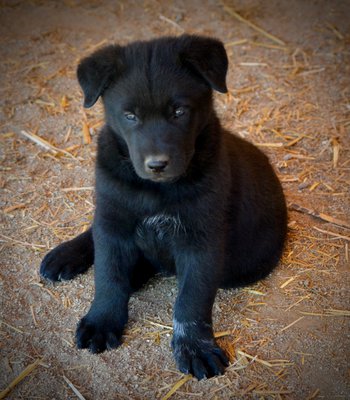Two things ALL puppies do
By Jennifer Stoeckl, MAT - Dire Wolf Project CEO, May 14, 2024
On Thursday of this week, the first puppy from the Luck of the Irish litter goes home to her new family.
Clover’s people will be so happy to have another puppy in the house again.
She is confident and brave… and loves to snuggle on my chest breathing in my scent as I caress her furry black coat.
Her vibrant personality can’t help but make friends easily.
But all puppies traveling home for the first time are somewhat out of sorts and disoriented.
You can help them to transition well by building a trusting, bonded relationship.
In order to do this, you need to be a good leader, looking out for the new puppy’s best interests at all times.
It takes observation, patience, persistence, and an established plan for consistent rules and routines.
The less chaotic you can make the transition, the better.
Puppies often go through a small mourning period at this time, as well.
This is because they have been taken abruptly from the only home they’ve ever known and thrust into a family with a very different lifestyle.
Not only is the family new and confusing, but each puppy will be alone for the first time in their life.
You must be the ANCHOR… a place a safety and security… where puppy can rely on for help and comfort.
You do this through paying attention to the new puppy, guiding it to learn the new rules as efficiently as possible.
Being prepared with a good puppy training strategy is a great way to get ready for the little one’s arrival.
Like… do you know what you are going to do when you encounter puppy behaviors you don’t like?
After all, the canine is a completely different species with rules, customs, and language quite foreign (and many times incompatible) to our human world.
For example,
ALL PUPPIES BITE.
That is because biting is how puppies play and show affection and camaraderie with their pack members.
It is a big part of canine culture.
But you can’t have your puppy biting your arm, pant leg, or child. It would hurt, because puppy teeth are SHARP.
You could scold puppy for biting (and you should let puppy know biting is unacceptable in a human world), but you also need to understand your puppy is not being BAD. Your puppy is doing EXACTLY what it does to make friends with other puppies in its own culture.
As the leader, you must show puppy that in the human world, biting is not allowed, while respecting puppy for not yet understanding that a HUGE cultural shift has just occurred.
Here’s another example,
ALL PUPPIES JUMP.
Delaney (one of our 7 week old puppies from the Luck of the Irish litter) LOVES affection.
She shows this by trying to get as close to my face as possible.
That’s because in the canine culture, puppies show affection to someone of authority by licking their face.
In the canine world, jumping up and licking another’s face is a SIGN OF SUBMISSIVE RESPECT.
Jumping on another is a sign of play.
But in our human world, we expect dogs to keep all four on the floor.
It doesn’t come naturally to a puppy because it’s NOT part of their culture.
Therefore,
Stopping puppy biting and jumping must be learned!
Getting a new puppy is like housing a foreign exchange student who doesn’t speak a lick of English nor do they know anything about our customs and taboos.
When a new puppy arrives, your home is the new host family for the puppy.
It is up to you to respect the culture from which your puppy comes, but also GUIDE them to understand our strange human ways and how to speak English fluently.
I never recommend punishing a puppy harshly.
They just simply don’t know the rules or the language yet to warrant this type of response.
Instead, I TEACH a puppy exactly what I expect it to do.
You could use the TOTAL IMMERSION method of puppy training and let puppy figure things out on its own as you live your life as you always have.
But this leads to a lot of trial and error, huge gaps in understanding, and lots of misunderstanding as puppy tries to discern how to navigate an entirely different world from anything it’s known before.
I prefer to teach puppies a few fundamental words and gestures first, then build on them in a sequential order. I use a puppy’s native language first, body language, then associate English with the gesture as they understand.
The first English words I teach puppies are:
- No (wrong, don’t do this again.)
- Yay! (good job, I’m proud of you.)
- Yes (correct answer)
- Uh huh (good try, but incorrect. Try again.)
- Okay (release)
- Puppy, puppy, puppy (in a high-pitched voice to draw them towards me or get them to follow)
- response to name
When you first get your puppy home from Dire Wolf Project headquarters, it knows #1, #2, #5, and #6.
It’s up to you to continue from there.
I have put together a bunch of articles on puppy training specifically to prepare you to bring home your new furry companion.
Here is the link to all of our puppy training articles:
https://direwolfproject.com/direwolf-guardians/puppy-training/
Jennifer Stoeckl is the co-founder of the Dire Wolf Project, founder of the DireWolf Guardians American Dirus Dog Training Program, and owner/operator of DireWolf Dogs of Vallecito. She lives in the beautiful inland northwest among the Ponderosa pine forests with her pack of American Dirus dogs.